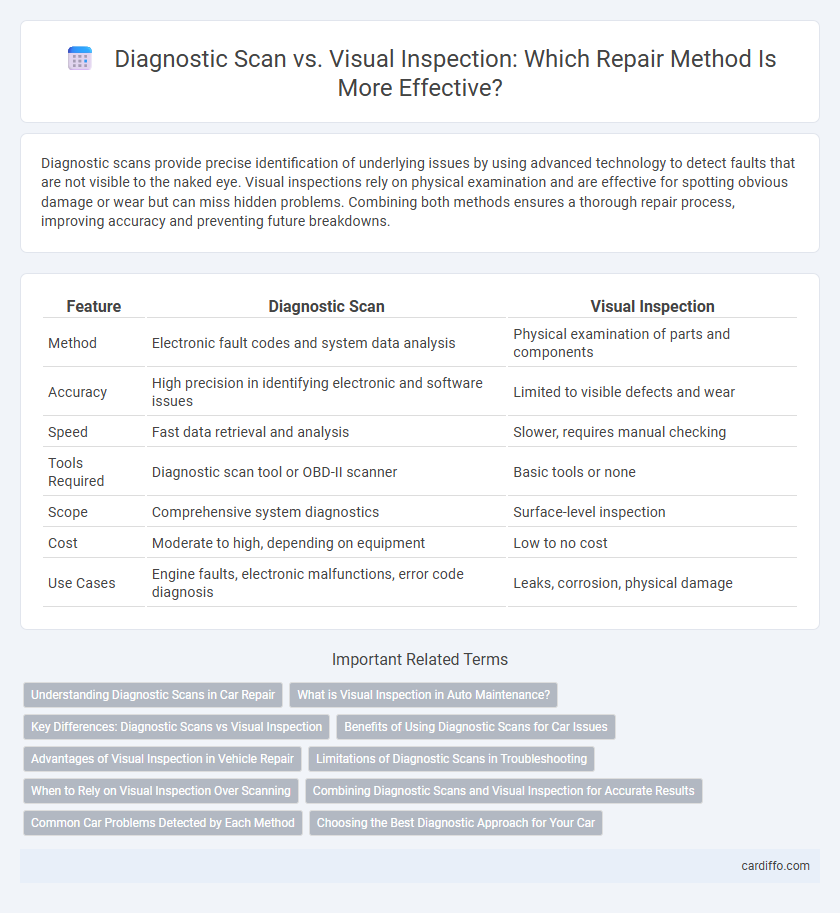Diagnostic scans provide precise identification of underlying issues by using advanced technology to detect faults that are not visible to the naked eye. Visual inspections rely on physical examination and are effective for spotting obvious damage or wear but can miss hidden problems. Combining both methods ensures a thorough repair process, improving accuracy and preventing future breakdowns.
Table of Comparison
| Feature | Diagnostic Scan | Visual Inspection |
|---|---|---|
| Method | Electronic fault codes and system data analysis | Physical examination of parts and components |
| Accuracy | High precision in identifying electronic and software issues | Limited to visible defects and wear |
| Speed | Fast data retrieval and analysis | Slower, requires manual checking |
| Tools Required | Diagnostic scan tool or OBD-II scanner | Basic tools or none |
| Scope | Comprehensive system diagnostics | Surface-level inspection |
| Cost | Moderate to high, depending on equipment | Low to no cost |
| Use Cases | Engine faults, electronic malfunctions, error code diagnosis | Leaks, corrosion, physical damage |
Understanding Diagnostic Scans in Car Repair
Diagnostic scans provide precise data by interfacing directly with a vehicle's onboard computer systems, detecting error codes and performance issues that visual inspections may miss. This technology enables mechanics to pinpoint problems such as sensor failures, engine malfunctions, and electronic faults quickly and accurately. Integrating diagnostic scans with a thorough visual inspection ensures a comprehensive approach to car repair, improving repair accuracy and reducing troubleshooting time.
What is Visual Inspection in Auto Maintenance?
Visual inspection in auto maintenance involves thoroughly examining the vehicle's components, such as belts, hoses, brakes, and fluid levels, to identify visible signs of wear, damage, or leaks. This method helps detect issues like corrosion, cracks, or loose connections that may not trigger diagnostic codes. While a diagnostic scan reads electronic trouble codes from the vehicle's computer system, visual inspection provides a hands-on assessment essential for comprehensive repair and preventive maintenance.
Key Differences: Diagnostic Scans vs Visual Inspection
Diagnostic scans leverage advanced electronic tools to identify hidden faults in vehicle systems, detecting error codes from the engine, transmission, or airbags that are invisible to the naked eye. Visual inspection relies on physical examination to identify obvious signs of wear, damage, or leaks, but may miss underlying electronic or sensor issues. Key differences include the depth of analysis, with diagnostic scans providing precise fault locations, while visual inspection depends on technician experience and visible evidence.
Benefits of Using Diagnostic Scans for Car Issues
Diagnostic scans provide precise identification of car issues by reading error codes from the vehicle's onboard computer system, enabling faster and more accurate troubleshooting compared to visual inspections alone. These scans can detect hidden problems within the engine, transmission, and electronic systems that are not visible to the naked eye, reducing the risk of misdiagnosis. Utilizing diagnostic tools enhances repair efficiency, minimizes unnecessary part replacements, and supports preventative maintenance through early detection of potential faults.
Advantages of Visual Inspection in Vehicle Repair
Visual inspection in vehicle repair offers immediate identification of obvious physical damage, corrosion, and wear that diagnostic scans may overlook, enabling quicker decision-making. It allows technicians to assess the condition of components such as belts, hoses, and fluid leaks without the need for specialized equipment. This cost-effective method supports early problem detection, reducing overall repair time and expenses.
Limitations of Diagnostic Scans in Troubleshooting
Diagnostic scans provide valuable error codes and system data but often lack the context needed to identify subtle mechanical or electrical issues. Visual inspection complements scans by detecting physical damage, wear, or loose connections that automated tools may overlook. Relying solely on diagnostic scans can result in incomplete troubleshooting and missed underlying problems.
When to Rely on Visual Inspection Over Scanning
Visual inspection is preferable when diagnosing surface-level issues such as cracks, corrosion, or obvious physical damage that scanning tools may miss. In situations where electronic components appear intact but performance issues persist, hands-on examination reveals subtle signs like discoloration or loose connections. Relying on visual inspection over diagnostic scans is crucial in early-stage troubleshooting to identify mechanical wear and environmental effects not detectable by electronic sensors.
Combining Diagnostic Scans and Visual Inspection for Accurate Results
Combining diagnostic scans with visual inspection enhances repair accuracy by leveraging precise electronic data alongside tangible, physical evidence of component wear or damage. Diagnostic scans detect underlying system faults through error codes and sensor data, while visual inspections identify external issues like leaks, corrosion, or loose connections that scans might miss. Integrating both methods ensures comprehensive fault detection and more reliable repair outcomes.
Common Car Problems Detected by Each Method
Diagnostic scans effectively identify electronic and sensor-related issues such as faulty oxygen sensors, malfunctioning ignition coils, and transmission errors, while visual inspections excel at detecting physical problems like worn brake pads, fluid leaks, and damaged belts. Common car problems detected by diagnostic scans include engine misfires and emission control failures, whereas visual inspection reveals body damage, tire wear, and loose connections. Combining both methods ensures comprehensive detection of internal and external vehicle issues, reducing the risk of overlooking critical repairs.
Choosing the Best Diagnostic Approach for Your Car
Choosing the best diagnostic approach for your car depends on the issue's complexity and symptoms. A diagnostic scan provides precise error codes from the vehicle's onboard computer, enabling targeted repairs for electronic or sensor-related problems. Visual inspection excels in identifying physical damage, wear, or leaks that may not trigger error codes but affect overall vehicle performance.
diagnostic scan vs visual inspection Infographic

 cardiffo.com
cardiffo.com